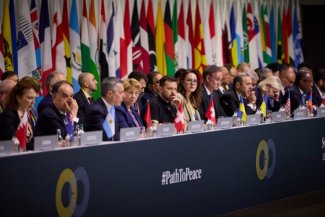Peace conference in Switzerland. Day 845 of the war

![]()
Russian forces are still advancing in most directions, but the gains they have made on the ground over the past week have not changed the military situation. The invaders have expanded the area they control in the direction of Pokrovsk, seizing Novooleksandrivka (according to some sources, the defenders are still holding on in the town’s western outskirts) and Novopokrovske. After capturing Heorhiyivka, the Russians moved on to the outskirts of Maksimilianivka, the last village between them and Kurakhove. The invading troops have occupied most of the so-called Kanal microdistrict in Chasiv Yar, while their subsequent attempts to gain a foothold on the western side of the Donets-Donbas canal have proved unsuccessful.
The Ukrainian reserves sent to Kharkiv oblast have undertaked offensive actions to regain lost territory, but so far they have not had much success. Fighting continues for Vovchansk, where defenders are still holding out in the northern part of the town. The invaders have withdrawn from the village of Tykhe, which lies in a depression to the east of it; this may be an attempt to draw the Ukrainian forces into a trap.
![]()
The invaders continued to launch air strikes against the direct hinterland of Ukrainian troops and major military airfields. Mirhorod in Poltava oblast was attacked at least four times (on 12, 15 and 16 June), Starokostiantyniv three times (14 June), and Kulbakino near Mykolaiv at least once (13 June). The Russians have begun to increase the number of missiles used to strike airfields (eight fell on Mirhorod on 15 June). On 12 June, during a rocket attack on Kyiv oblast, an industrial facility was hit (officially by falling debris), resulting in one of the largest fires since February 2022. Ukrainian services took more than three days to extinguish it, using 111 fire engins and four fire trains. Russian missiles targeted Novomoskovsk by the Dnieper (12 and 13 June), Zaporizhzhia (12 and 14 June) and Odesa (17 June), among other locations. The police headquarters, and according to some sources the local command centre of the Ukrainian Military Intelligence Service (HUR), were hit during a strike on Kryvyi Rih on 12 June. Local authorities reported nine civilian fatalities and 32 wounded. In total, from the evening of 11 June until the morning of 18 June, the invaders allegedly used 48 missiles, with the defenders claiming to have shot down 12 of them. In contrast, the Ukrainian Air Force Command announced a 100 per cent success rate against the Shahed drones, 51 of which were destroyed.
![]()
The Russian air defence systems are still the main target of Ukrainian attacks on Crimea. On 13 June, ATACMS missiles struck the locations of three missile squadrons. Satellite imagery confirmed the destruction of a mobile command post with radar illumination and guidance complex S-300PS (5N63S) near Yevpatoria. 14 June saw the largest Ukrainian drone attack to date on a single target, the Morozovsk airfield in Rostov oblast (70 drones were used). Satellite images show several hits on parking areas and one on a hangar (the Russians had previously evacuated the aircraft). A total of 87 drones were used by the Ukrainians on that day: they also attacked (without much success) a fuel base in Voronezh oblast and other targets in Kursk oblast. On 18 June, drones struck fuel depots in Azov in Rostov oblast and in the Tiemryuk region of Krasnodar krai; both resulted in fires. In contrast, the attacks on Rostov oblast on 15 June (including another strike on the refinery at Novoshakhtinsk), and on Lipetsk city and Voronezh oblast on 17 June, did not yield results.
![]()
On 13 June, the 23rd meeting of the Ramstein Group of States in Support of Ukraine took place. Canada confirmed its earlier announcements that it would send Kyiv 2300 decommissioned CRV7 unguided air-to-air missiles, 29 Nanuk remote weapon systems, 130,000 rounds of small arms ammunition and 50 armoured vehicles (four medical-evacuation versions have already been sent to Ukraine; another six are expected to arrive in the autumn, and 40 more, in other specialised versions, in 2025-6). Norway will provide grenade launcher ammunition worth €41.8 million, while the Netherlands has announced the donation of a batch of 152-mm artillery shells as part of the International Fund for Ukraine coordinated by the UK; so far the nine countries participating have raised €350 million.
In the days leading up to the meeting, Lithuania announced that it was sending Kyiv 14 M113 tracked transporters, and Estonia will send a Mistral very short-range missile launcher with rockets. The Netherlands announced the allocation of €60 million for the purchase of naval drones and FPVs, and Germany the transfer of 100 missiles for Patriot systems (32 were already due to arrive in Ukraine, with another 68 to be sent “over the coming weeks”). On 14 June, Berlin updated the list of equipment it has delivered, including three HIMARS launchers, 20 Marder infantry fighting vehicles, 10 Leopard 1A5 tanks, one IRIS-T SLM and one IRIS-T SLS air defence system, 21,000 155-mm missiles and 400,000 small arms cartridges.
According to Le Monde, France has agreed to train 26 Ukrainian pilots over the next two years. This is most likely to be basic training. Currently, 10 Ukrainians are being taught piloting in France; due to their relatively young age (21-23), they will be the first group of pilots in the local army who have never flown Soviet-designed aircraft.
Ukraine’s minister for strategic industries Oleksandr Kamyshin has confirmed that the first Lynx infantry fighting vehicles will be produced in Ukraine in 2024. The start of their production, at a location undisclosed for security reasons, was announced by Armin Papperger, the CEO of Germany’s Rheinmetall. Achieving this within the timeframe presented will only be possible if an assembly plant is set up in Ukraine which can assemble infantry fighting vehicles from components supplied by the German company. The plan should be seen primarily as another promotional action by Rheinmetall, which over the last two years has already announced it would build four factories in Ukraine. Production of Panther tanks was to have started there this year, but at present this is out of the question.
On 12 June, countries participating in the Conference for the Reconstruction of Ukraine in Berlin committed an additional $35 million to support demining. The total amount pledged and earmarked for the removal and neutralisation of dangerous objects by partner countries has so far reached more than $850 million for the period 2022-7. According to the Ukrainian ministry of economy, since the beginning of the war Kyiv has restored to use some 30,000 km2 of territory that had previously been occupied or where hostilities had taken place. There are currently 144,000 km2 of land waiting to be demined.
On 13 June, Ukraine and the United States concluded a security agreement aimed at strengthening Kyiv’s defence capabilities. It is intended to “support a bridge to Ukraine’s eventual NATO membership” and states Washington’s commitment to defending the country’s sovereignty and territorial integrity. The US side confirmed that it would send Patriot missile systems and F-16 fighter jets. It is noteworthy that the document emphasises the importance of co-operation in implementing reforms in Ukraine – including anti-corruption measures and respect for human rights & the rule of law – which will deepen its integration into the Alliance. On the same day, an agreement on support and cooperation was signed between Ukraine and Japan. Tokyo pledged to send $4.5 billion in financial assistance by the end of the year. Ukraine has already concluded 17 security cooperation agreements, with the UK, Germany, France, Denmark, Canada, Italy, the Netherlands, Finland, Latvia, Spain, Belgium, Portugal, Sweden, Norway, Iceland, the US and Japan.
The peace summit in Switzerland on 15-16 June was attended by 93 countries and international organisations. Delegations from China did not attend, and those from Brazil and the Vatican acted as observers. Representatives of the 78 participating countries signed a final communiqué (which India, South Africa, Saudi Arabia and Armenia, among others, refused to sign), which reaffirmed the commitment to refrain from the use or threat of force against the territorial integrity or political independence of Ukraine within its internationally recognised borders. It was agreed that the Zaporizhzhia Nuclear Power Plant must be returned to the control of Kyiv and placed under the monitoring of the International Atomic Energy Agency. Attacks on merchant ships and ports in the Sea of Azov and the Black Sea were declared unacceptable, and the right of Ukraine to export agricultural products safely and freely was reaffirmed. It called for the release of all prisoners of war and the return of ‘deported and illegally displaced’ children to Ukraine. It was also stated that achieving peace required the participation of all parties – that is, including Russia.
The text of the communiqué was the result of a broad compromise. It did not expressly condemn Russia for its aggression (the phrase ‘the Russian Federation’s war against Ukraine’ was used) or call on it to withdraw its troops. The summit was attended by a smaller number of states represented at the highest level than Kyiv had expected. Among the positive outcomes of the meeting is the indication that only the UN Charter and international law can be the basis for peace talks. Ukraine did not exclude Russia’s participation in the next planned event of this type, but this does not mean that it is ready to make concessions regarding sovereignty or the changes to the 1991 borders.
![]()
On 14 June, Vladimir Putin announced that there were nearly 700,000 Russian military personnel in the special military operation zone. This marks a significant increase on Moscow’s previous figures: in December 2023, 617,000 troops were participating in the so-called special military operation. According to HUR, the invaders have amassed more than 500,000 military personnel in the occupied territories. On 13 June, US Secretary of Defence Lloyd Austin presented the Ramstein Group participants with the latest US estimate of Russian losses as of February 2022: 350,000 dead and wounded. According to Kyiv’s latest figures (January this year), the defending forces number 880,000 troops, a figure that has continued to fall in recent months (from 1 million in the summer of 2022).
On 14 June, South Korean Defence Minister Shin Won-sik announced that North Korea had sent at least 10,000 containers capable of holding a total of 4.8 million artillery shells to Russia, which in exchange for these munitions is providing North Korea with technology to help deploy a network of spy satellites and conventional armaments.
![]()
On 16 June, Ukraine’s justice minister Denys Maluska stated that more than 2750 convicted men had been conscripted; according to his assessment, another 4000 are interested in signing up. Those conditionally released will serve only in assault units consisting exclusively of former prisoners. Maluska added that the army could recruit between 10,000 and 20,000 convicts.
![]()
On 14 June, Ukrainian police said that since the beginning of the year Russian special services had increased their monitoring of social networks, and were recruiting teenagers to carry out diversionary activities such as setting fire to cars used by the military. So far, several perpetrators between the ages of 13 and 18 have been detained, setting fires in Odesa, Kyiv and Dnipro.
![]()
On 17 June, the Kyiv International Sociological Institute published a poll in which respondents were asked whether they supported the mobilisation law in force which was introduced on 18 May. Only 34% of respondents answered in the affirmative, 32% were opposed, 20% were reserved and 14% refused to answer. The research indicates growing war weariness and fear of losing their lives in the brutal frontline fighting.






